The thorny path of evolution of synthesizers: the forgotten history of revolutionary inventions
Synthesizers have long been familiar and mundane. Virtually all modern composers, performers and sound producers (if not to take into account the academic classics) somehow use them. At the same time, a huge theoretical and practical contribution of people, thanks to whose efforts musicians and composers have almost unlimited possibilities, remains unfairly forgotten.

In this article I want to draw the attention of readers to unknown, but extremely significant inventions and their creators. Those whose efforts influenced the history of music, the development of musical equipment, the industry of electronic instruments, have left a significant mark on the culture, presenting new possibilities to musicians and composers. In addition, not entirely successful attempts to create synthesizer prototypes, which are worthy of attention, will be considered, because the ideas embodied in these start-ups that were doomed to failure have given a powerful impetus to development.
This article describes only a few developments that appeared from 1850 to 1964. Due to the bulk of the topic, we decided to divide the material into several parts.
Perhaps the first attempt to create an electrical sound synthesizer can be considered the experiments of the German physicist Hermann Gomenholts, who in the 80s of the last century combined electromagnetic exciters, tuning forks and keys in one device. The apparatus, which was called the “Large Helmholtz apparatus for connecting timbres of 10 harmonics,” cannot be called a musical instrument, but the basic idea of the great physicist gave impetus to development.
')
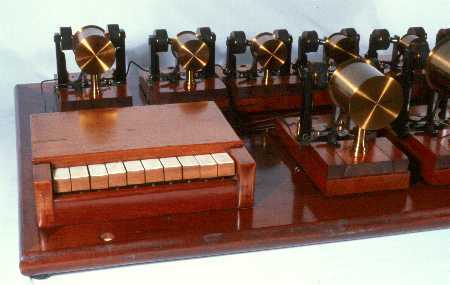
The device, later called the Fourier synthesizer, was equipped with ten electrically excitable tuning forks located near the cavity opening. These tuning forks were tuned to the frequency of the resonator. When turned on, they sounded all at once while emitting a quiet sound. When you press a key, the cap of the corresponding resonator deviated from the hole and the volume of the sound increased. The vibration of the resonators was extinguished using a special rubber gasket. The component of each harmonic was varied by changing the force of pressing the corresponding key.

In 1876, engineer Elisha Gray presented and received a patent for his "musical telegraph" - in fact, it was a regular telegraph, the keys of which were connected to the speakers. When you press the keys, the sound of the message is played.
The transmitter, which was originally capable of creating 2 tones, after the modernization turned into a two octave device, which was capable of generating and transmitting already 24 sounds of different pitch (two octaves) along a telegraph line.
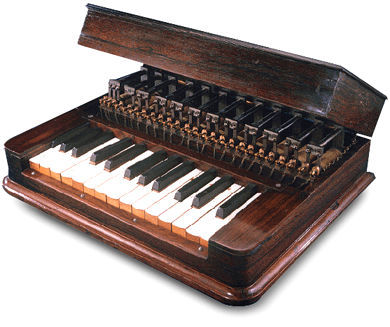
Some historians believe that it was Gray’s invention that was the first prototype of a modern synthesizer , although the device was more likely a by-product of the work of its creator and did not receive recognition as a musical instrument.
In 1895, the talented American inventor Tadeusz Cahill received a patent for an invention with the loud title “The Principle and Device for Playing and Distributing Music Using Electricity”. In 1906, a sample instrument appeared that many consider to be a prototype of a synthesizer . To create the device, Cahill and his 50 employees spent 4 years of work.
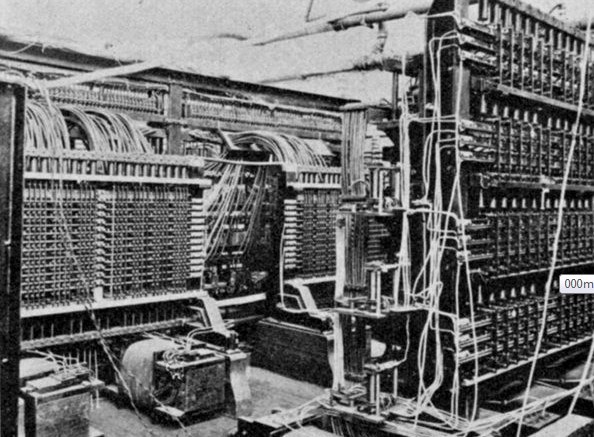
The bulky device weighed 200 tons, combining 145 generators, producing alternating electric current of various frequencies, a complex system of inductors, which allowed to produce additive sound synthesis. The tools were controlled using three seven-octave keyboards.
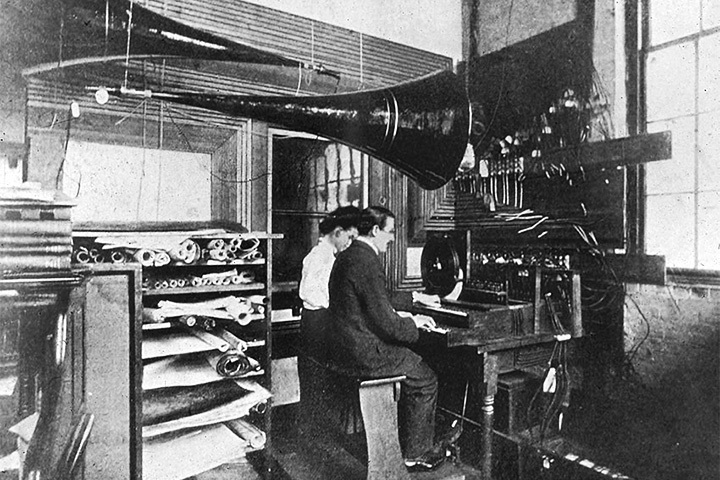
An interesting fact is that the tellarmonium was the first electric musical instrument with a dynamic keyboard, where the amplitude response of the signal depended on the strength of keystrokes. Giant horn loudspeakers were responsible for playing the sound in the first versions of the instrument, and later the sound of the instrument was transmitted directly via telephone lines.
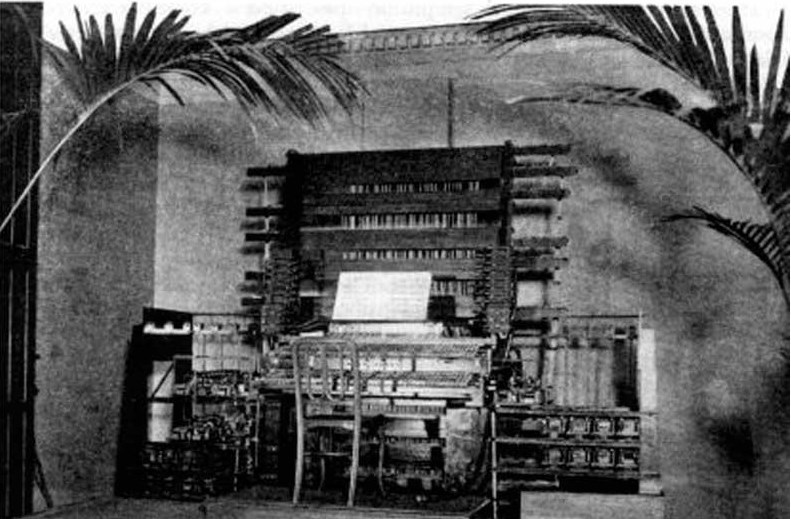

In total, 3 tellarmoniums were built, the third largest and most powerful saw the light of the year 1911. After contacting the New England Electric Music Company after a brief presentational success, Cahill planned to broadcast the instrument's music everywhere, where there is a telephone.
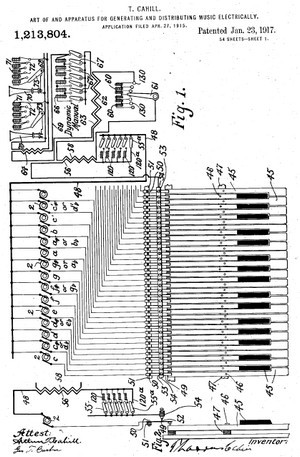

The plans of the inventor did not come true. The device gave a signal with a current of about one ampere to each telephone set; this allowed listening to music without even holding the phone to its ear, but it was extremely detrimental to the telephone lines of that time. As a result, he received an impressive suit from the telephone company, as well as a storm of discontent from users of telephone networks, as the instrument’s concerts were accompanied by serious interference. The concerts of the Tellarmonium finally stopped in 1916, and the inventor for years ahead of his era died in poverty in 1932.

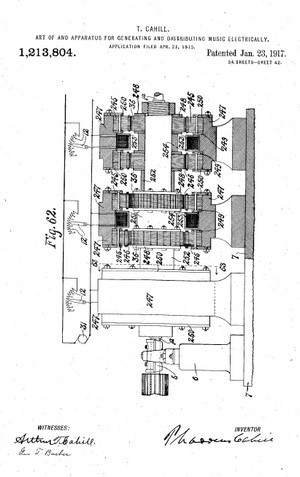
The success of the Russian physicist, inventor and musician Lev Termen in 1921 who created, the first electromusical instrument - the Theremin, became the catalyst for the development of research on the creation of EMR. You can find a detailed description of his inventions in one of our materials .
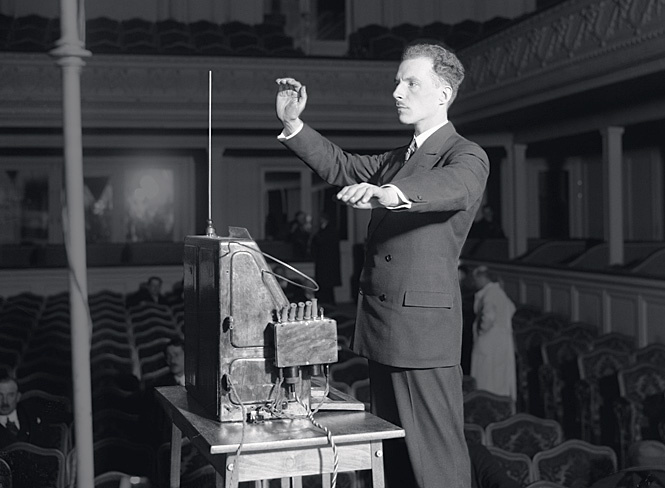
Continuing his work in this area, in 1931, Theremin creates a "rhythmicon" - the first analog rhythm synthesizer , in fact, the first drum machine.

Electrophone or in a different way “Marteno Waves” (fr. Ondes Martenot) is a monophonic electronic musical instrument, created in 1928 by French cellist and educator Maurice Martenot. The instrument has a 7-octave piano-type keyboard, as well as a thread with a ring, thanks to which you can also extract sounds.
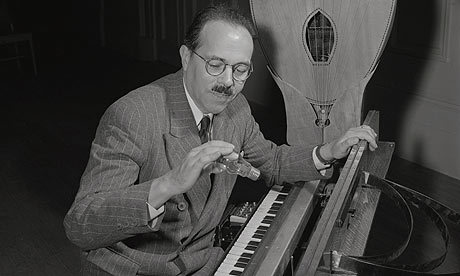
The electric “heart” of the instrument was a “warm” tube generator, which was controlled via the keyboard or by tightening the thread to a certain position and simultaneously pressing a special button that served as a bow. The dynamic characteristics of the performance were also regulated through a “bow” button, the force and pressure of which depended on the attack and volume.
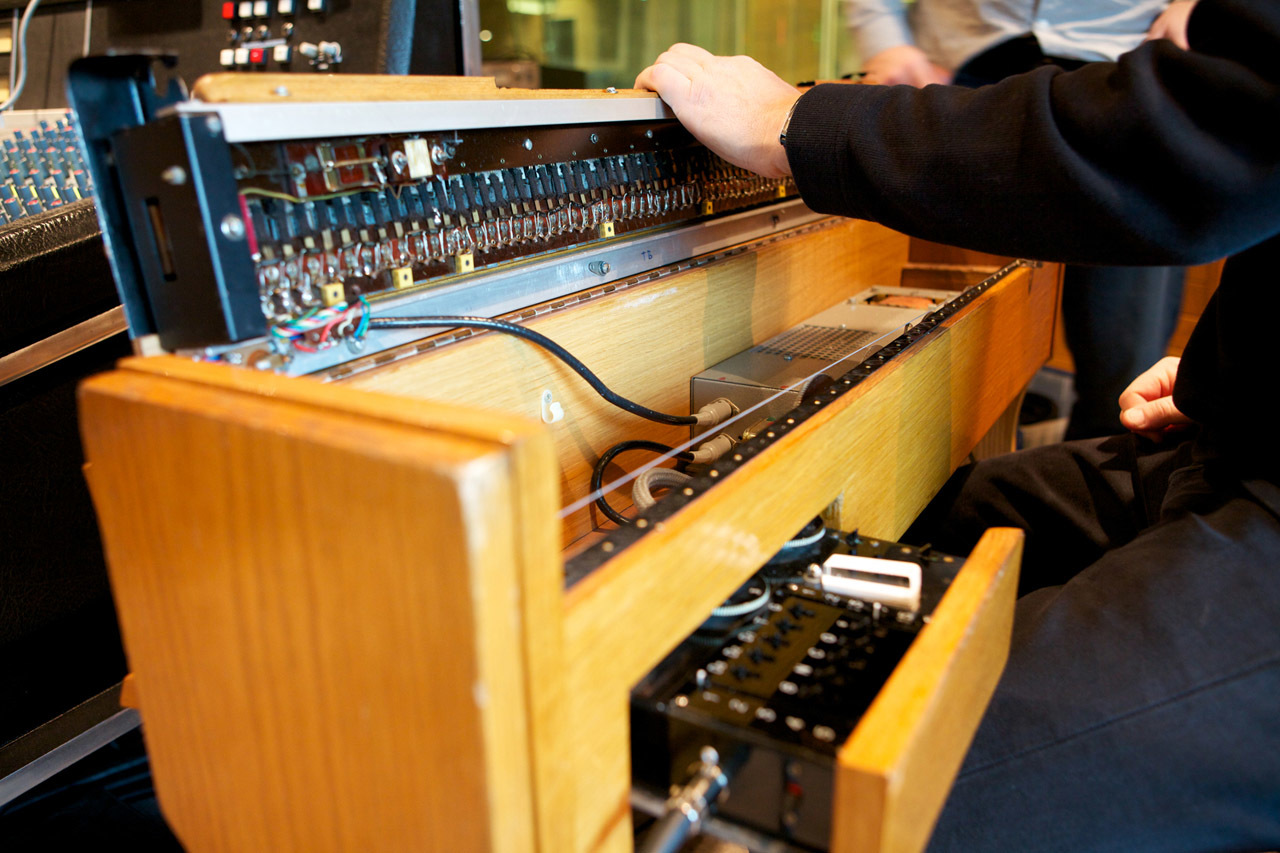
In addition, the instrument was equipped with switches for timbres and performance modes (keyboard / thread). Subsequently, the creator of the instrument created a more advanced keyboard, which made it possible to obtain intervals of 1 / 12th tone.
It is characteristic that the musician laid several unusual sound techniques typical of stringed instruments, for example, the vibrato was obtained by shifting the key to the side, and the glissando with a smooth movement of the finger with the ring along the keys.

Waves, in spite of limited commercial success, turned out to be long-livers. The tool was modernized several times, in the 70s a transistor version appeared, in the 90s, thanks to the Radiohead group, a digital analogue of the device was released. The team gave the instrument a second life, performing the composition How To Disappear Completely with it for the first time in 2000.

Like the Theremin, the “Martenot Waves” were not a massive, but a popular tool of their time. Prominent composers of the 30s - 40s wrote several works for the instrument. Waves are heard in the works of composers such as: Dimitrios Levidis, Olivier Messiaen, E. Varese, A. Jolive, S. Köcklena, D. Millau, A. Onegger.
The Soviet development of electromusical instruments, the flesh until the end of the 50s, the beginning of the 60s remain in the shadows, but at the same time the contribution of the Soviet designers to the idea of the Soviet synthesizer is difficult to overestimate. In the 1930s, a whole range of tools was developed, the work on which formed a theoretical and practical basis for more than significant successes in this area in the postwar period.

Among the promising developments, the keyboards were especially successful: “Ekvodin” (prototypes: B-5, B-7, B-8) designed by A.A. Volodin, "companol" and "them" I. D. Simonov. In addition, the signature instrument sonar by engineer N. S. Ananev and the Violen by V. A. Gurov were developed.
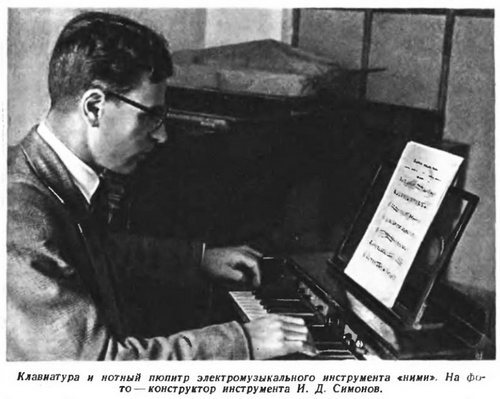
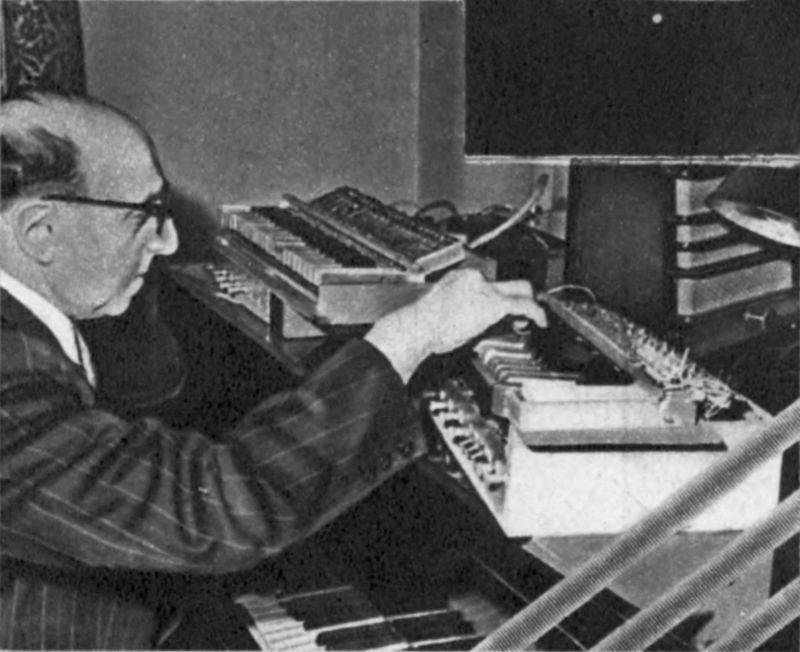
Each of these instruments contributed to the creation of a full-fledged synthesizer . The instruments were designed on the basis of radio tubes and oscillators, and had quite interesting possibilities for controlling the timbre color of the sound. The models were rather experimental, but the practical base was developed precisely during their creation.
The most successful constructions of that period are considered “emriton” A.A. Ivanova and A.V. Rimsky-Korsakov, a modified version of the tool "Ekvodin" "B-9" A.A. Volodin, as well as the original polyphonic project created by the Riga radio amateur L. Wingris.
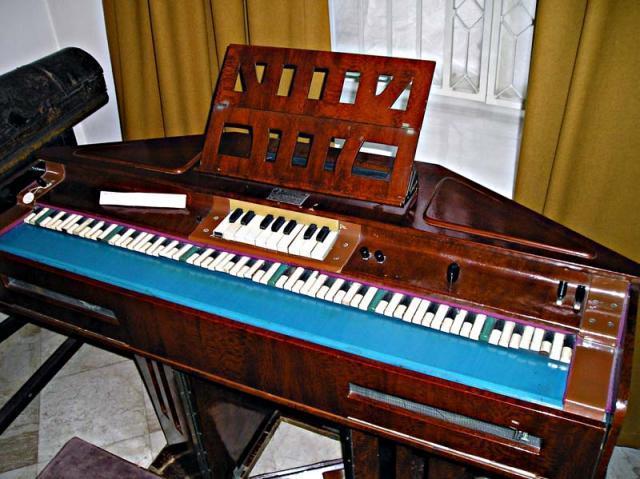

Work on these tools was completed in the 50s, although the design and experimental prototyping, for example, of the apparatus, Ekvodin began in the early 30s. The creator of this device, Andrei Volodin, deserves special attention as a physicist, engineer, music theorist, and most importantly, as one of the most impressive Soviet researchers in the field of psychoacoustics.
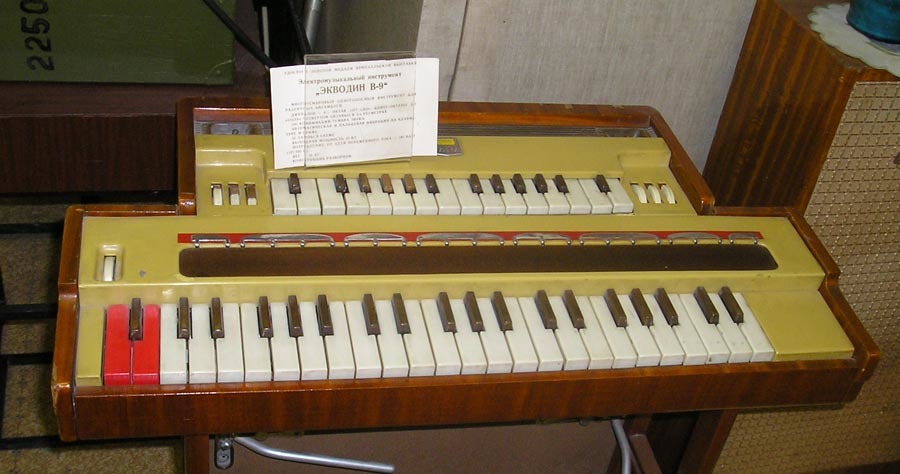
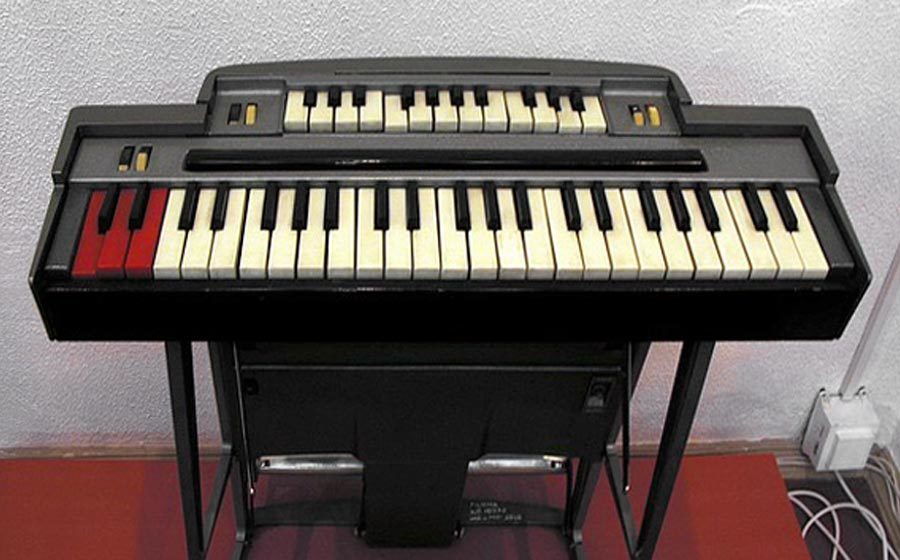
The article “Electromusical Instruments” by V. Ostrovsky and A. Simonov, “Science and Technology”, No. 4, 1964 tells quite a lot about the development of electronic instruments of this period. In addition to the above-mentioned Soviet developments, it mentions such tools as “Shumofon”, “Kristadin”, “Kompofonof” and others. Below I present a table published in this article, which gives some ideas about the possibilities of Soviet developments of the period described (the chronology in the table is possibly distorted; from the “Youth Techniques” numbers of 30s, you can make an assumption that “Violen” and “Sonar” appeared later th year).
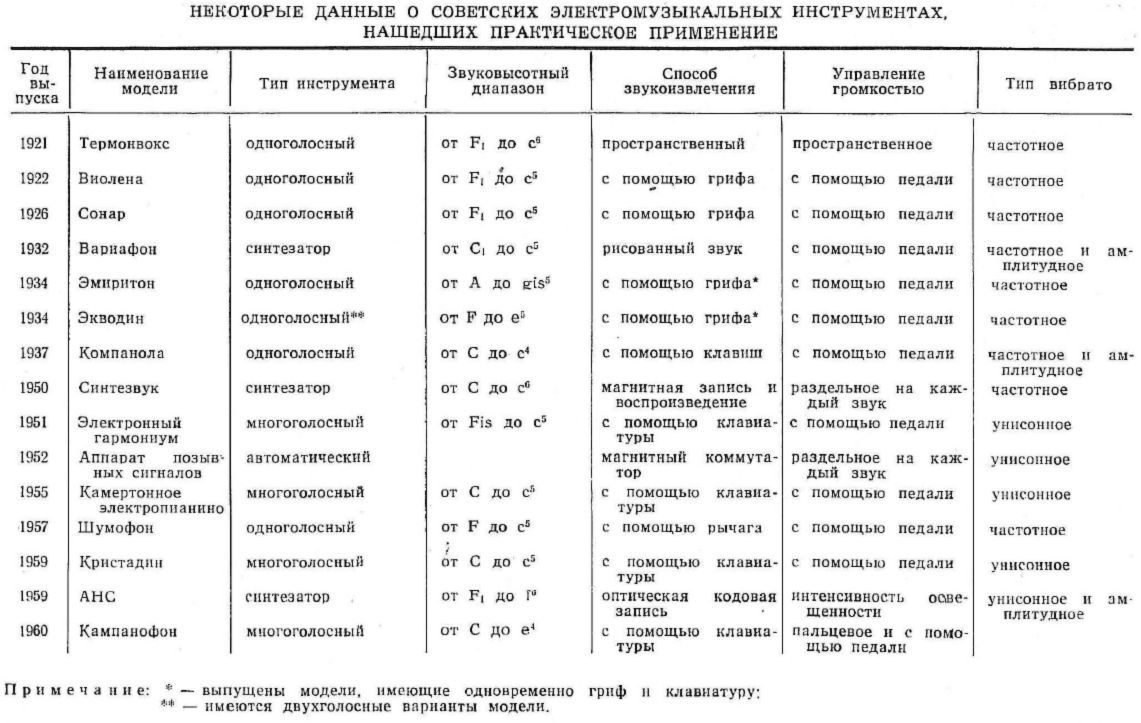
In 1930, Friedrich Trotwein created one of the most famous power tools of the time - Trautonium. An analog synthesizer built on the basis of several tube oscillators and an oscillating circuit. Instead of a keyboard, the trautonium was equipped with sensitive resistive bands that perform the function of a rheostat.
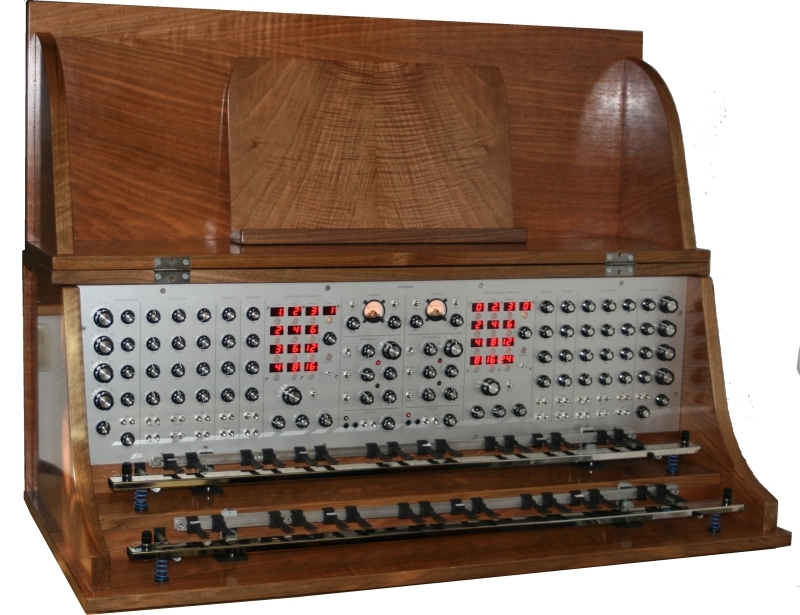
The most significant advantage of the instrument was an incredibly rich palette of sounds, which was formed by a large number of generators, regulators, as well as special filters that affect the waveform. The first version of the tool was released by the legendary company Telefunken.
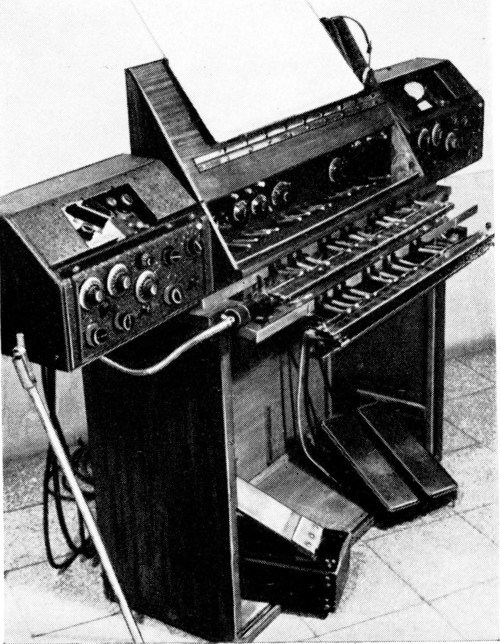
The modernized models of trautonium, created by the German physicist and composer Oscar Sal, are rightly considered the best analog synthesizers of the 40s. In later models of the device, special metal fasteners were added to the resistive strips, which made it possible to mark the location of certain tones.

As in the case of the Marteno waves, the trautonium won the love of the composers of its time. A number of works were written directly for this instrument, such as “Concertino for Trautonium with Orchestra” by Paul Hindemith and “Concert for Trautonium and Large Orchestra” by Harald Gentsmer.
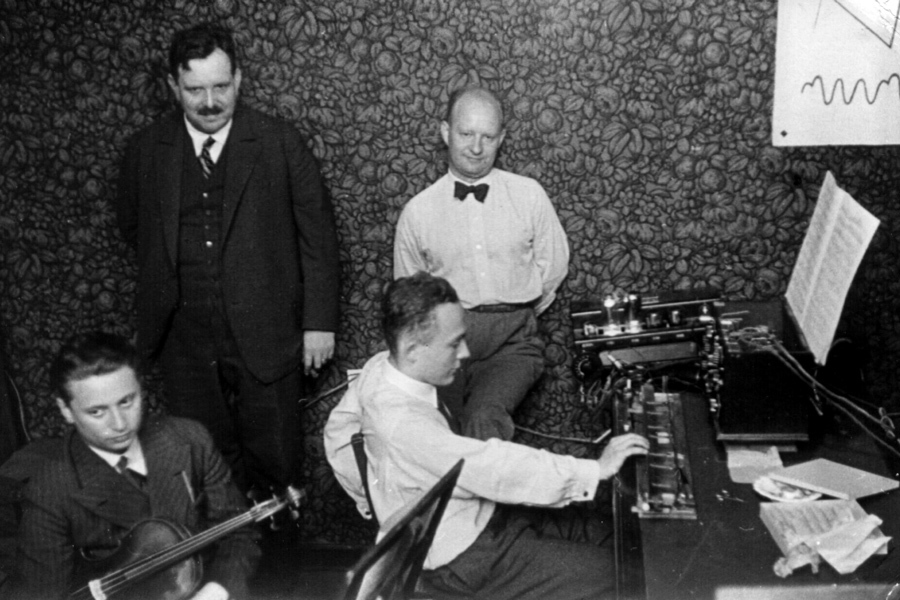
In the postwar years, the tool continued to enjoy limited popularity, and the tireless enthusiast Oscar Sala continued to modernize it. A well-known fact is that trautonium is used to create effects for Alfred Hitchcock’s film “Birds”, which Oscar Sala also worked on.
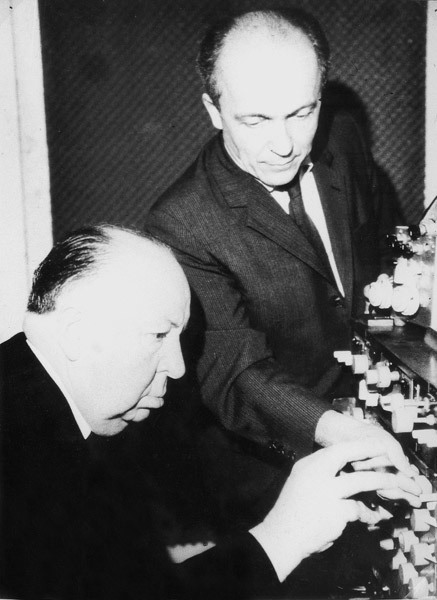
ANS is one of the most impressive Soviet projects created by military engineer Yevgeny Murzin. The inventor called the synthesizer "ANS" in honor of the Russian composer Alexander Nikolaevich Scriabin. ANS became the first multi-voiced synthesizer in the world, besides it was recognized as the first studio synthesizer, as well as the first in the world automatic analogue electronic music instrument using photo-optical sound synthesis.

In fact, the ANS is an optical multi-voiced sequencer that allows you to play a piece previously recorded on a transparent plate. The recording was carried out by erasing the opaque layer from it and is a peculiar spectrogram of the sound recorded in the score. During playback, the drive moves the plate in front of the slit. A beam of light, modulated using 4 transparent discs with a specific pattern, falls through a slit on the part of the scoreboard, and then onto the photocells. The position of the lumen in the plate determines the pitch (frequency), and the width the volume (amplitude).
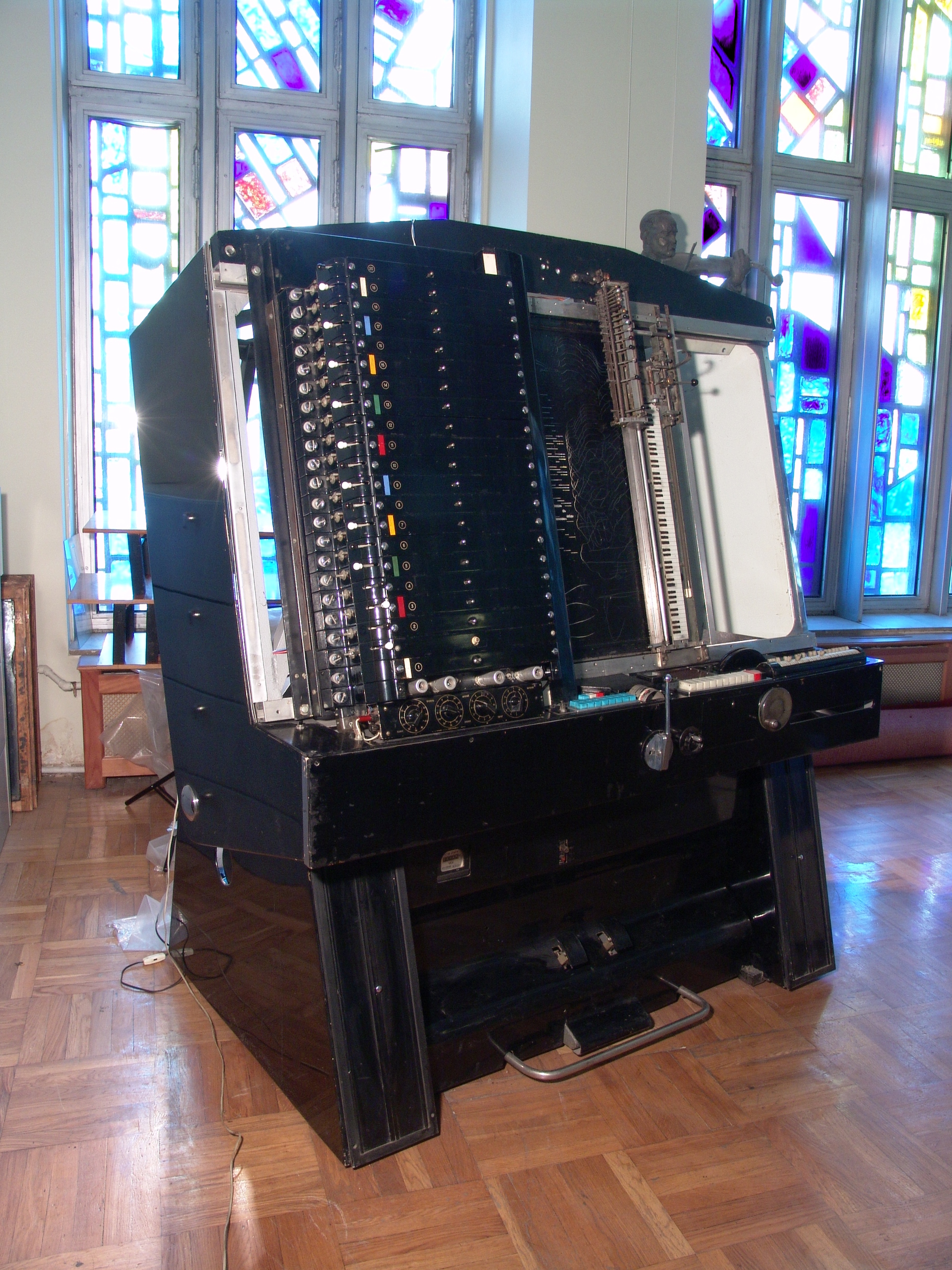
The uniqueness and revolutionary nature of this development, as in many cases with Soviet inventions, did not become a sufficient reason for mass production of the instrument. Despite this, the device was very popular among Soviet composers, including such names as Alfred Schnittke, Edison Denisov, Sofia Gubaidulina, Andrei Volkonsky, Stanislav Kreichi, Petr Meshchaninov, Alexander Nemtin.

One of the most famous works written for ANS, was the soundtrack to the film Andrei Tarkovsky "Solaris" based on the work of science fiction writer Stanislav Lem. The possibilities of developing Murzin are impressive musicians to this day, it suffices to recall such experimental groups as Coil (ANS album - 2003) and Bad Sector.

In this article I want to draw the attention of readers to unknown, but extremely significant inventions and their creators. Those whose efforts influenced the history of music, the development of musical equipment, the industry of electronic instruments, have left a significant mark on the culture, presenting new possibilities to musicians and composers. In addition, not entirely successful attempts to create synthesizer prototypes, which are worthy of attention, will be considered, because the ideas embodied in these start-ups that were doomed to failure have given a powerful impetus to development.
This article describes only a few developments that appeared from 1850 to 1964. Due to the bulk of the topic, we decided to divide the material into several parts.
Gomengolts experiments - Fourier synthesizer
Perhaps the first attempt to create an electrical sound synthesizer can be considered the experiments of the German physicist Hermann Gomenholts, who in the 80s of the last century combined electromagnetic exciters, tuning forks and keys in one device. The apparatus, which was called the “Large Helmholtz apparatus for connecting timbres of 10 harmonics,” cannot be called a musical instrument, but the basic idea of the great physicist gave impetus to development.
')

The device, later called the Fourier synthesizer, was equipped with ten electrically excitable tuning forks located near the cavity opening. These tuning forks were tuned to the frequency of the resonator. When turned on, they sounded all at once while emitting a quiet sound. When you press a key, the cap of the corresponding resonator deviated from the hole and the volume of the sound increased. The vibration of the resonators was extinguished using a special rubber gasket. The component of each harmonic was varied by changing the force of pressing the corresponding key.

Elisha Gray - musical telegraph
In 1876, engineer Elisha Gray presented and received a patent for his "musical telegraph" - in fact, it was a regular telegraph, the keys of which were connected to the speakers. When you press the keys, the sound of the message is played.
The transmitter, which was originally capable of creating 2 tones, after the modernization turned into a two octave device, which was capable of generating and transmitting already 24 sounds of different pitch (two octaves) along a telegraph line.

Some historians believe that it was Gray’s invention that was the first prototype of a modern synthesizer , although the device was more likely a by-product of the work of its creator and did not receive recognition as a musical instrument.
Telarmonium Tadeusz Kehill - the collapse of the organ concerts on the telephone lines
In 1895, the talented American inventor Tadeusz Cahill received a patent for an invention with the loud title “The Principle and Device for Playing and Distributing Music Using Electricity”. In 1906, a sample instrument appeared that many consider to be a prototype of a synthesizer . To create the device, Cahill and his 50 employees spent 4 years of work.

The bulky device weighed 200 tons, combining 145 generators, producing alternating electric current of various frequencies, a complex system of inductors, which allowed to produce additive sound synthesis. The tools were controlled using three seven-octave keyboards.

An interesting fact is that the tellarmonium was the first electric musical instrument with a dynamic keyboard, where the amplitude response of the signal depended on the strength of keystrokes. Giant horn loudspeakers were responsible for playing the sound in the first versions of the instrument, and later the sound of the instrument was transmitted directly via telephone lines.


In total, 3 tellarmoniums were built, the third largest and most powerful saw the light of the year 1911. After contacting the New England Electric Music Company after a brief presentational success, Cahill planned to broadcast the instrument's music everywhere, where there is a telephone.


The plans of the inventor did not come true. The device gave a signal with a current of about one ampere to each telephone set; this allowed listening to music without even holding the phone to its ear, but it was extremely detrimental to the telephone lines of that time. As a result, he received an impressive suit from the telephone company, as well as a storm of discontent from users of telephone networks, as the instrument’s concerts were accompanied by serious interference. The concerts of the Tellarmonium finally stopped in 1916, and the inventor for years ahead of his era died in poverty in 1932.


Star of Lev Theremin - the birth of electronic music
The success of the Russian physicist, inventor and musician Lev Termen in 1921 who created, the first electromusical instrument - the Theremin, became the catalyst for the development of research on the creation of EMR. You can find a detailed description of his inventions in one of our materials .

Continuing his work in this area, in 1931, Theremin creates a "rhythmicon" - the first analog rhythm synthesizer , in fact, the first drum machine.

Martenot Waves - the wonders of the sound
Electrophone or in a different way “Marteno Waves” (fr. Ondes Martenot) is a monophonic electronic musical instrument, created in 1928 by French cellist and educator Maurice Martenot. The instrument has a 7-octave piano-type keyboard, as well as a thread with a ring, thanks to which you can also extract sounds.

The electric “heart” of the instrument was a “warm” tube generator, which was controlled via the keyboard or by tightening the thread to a certain position and simultaneously pressing a special button that served as a bow. The dynamic characteristics of the performance were also regulated through a “bow” button, the force and pressure of which depended on the attack and volume.

In addition, the instrument was equipped with switches for timbres and performance modes (keyboard / thread). Subsequently, the creator of the instrument created a more advanced keyboard, which made it possible to obtain intervals of 1 / 12th tone.
It is characteristic that the musician laid several unusual sound techniques typical of stringed instruments, for example, the vibrato was obtained by shifting the key to the side, and the glissando with a smooth movement of the finger with the ring along the keys.

Waves, in spite of limited commercial success, turned out to be long-livers. The tool was modernized several times, in the 70s a transistor version appeared, in the 90s, thanks to the Radiohead group, a digital analogue of the device was released. The team gave the instrument a second life, performing the composition How To Disappear Completely with it for the first time in 2000.

Like the Theremin, the “Martenot Waves” were not a massive, but a popular tool of their time. Prominent composers of the 30s - 40s wrote several works for the instrument. Waves are heard in the works of composers such as: Dimitrios Levidis, Olivier Messiaen, E. Varese, A. Jolive, S. Köcklena, D. Millau, A. Onegger.
Forgotten contribution: USSR, 30-50 years of the last century
The Soviet development of electromusical instruments, the flesh until the end of the 50s, the beginning of the 60s remain in the shadows, but at the same time the contribution of the Soviet designers to the idea of the Soviet synthesizer is difficult to overestimate. In the 1930s, a whole range of tools was developed, the work on which formed a theoretical and practical basis for more than significant successes in this area in the postwar period.

Among the promising developments, the keyboards were especially successful: “Ekvodin” (prototypes: B-5, B-7, B-8) designed by A.A. Volodin, "companol" and "them" I. D. Simonov. In addition, the signature instrument sonar by engineer N. S. Ananev and the Violen by V. A. Gurov were developed.


Each of these instruments contributed to the creation of a full-fledged synthesizer . The instruments were designed on the basis of radio tubes and oscillators, and had quite interesting possibilities for controlling the timbre color of the sound. The models were rather experimental, but the practical base was developed precisely during their creation.
The most successful constructions of that period are considered “emriton” A.A. Ivanova and A.V. Rimsky-Korsakov, a modified version of the tool "Ekvodin" "B-9" A.A. Volodin, as well as the original polyphonic project created by the Riga radio amateur L. Wingris.


Work on these tools was completed in the 50s, although the design and experimental prototyping, for example, of the apparatus, Ekvodin began in the early 30s. The creator of this device, Andrei Volodin, deserves special attention as a physicist, engineer, music theorist, and most importantly, as one of the most impressive Soviet researchers in the field of psychoacoustics.


The article “Electromusical Instruments” by V. Ostrovsky and A. Simonov, “Science and Technology”, No. 4, 1964 tells quite a lot about the development of electronic instruments of this period. In addition to the above-mentioned Soviet developments, it mentions such tools as “Shumofon”, “Kristadin”, “Kompofonof” and others. Below I present a table published in this article, which gives some ideas about the possibilities of Soviet developments of the period described (the chronology in the table is possibly distorted; from the “Youth Techniques” numbers of 30s, you can make an assumption that “Violen” and “Sonar” appeared later th year).

Trautonium - the triumph of Friedrich Tortwein and Oscar Sal
In 1930, Friedrich Trotwein created one of the most famous power tools of the time - Trautonium. An analog synthesizer built on the basis of several tube oscillators and an oscillating circuit. Instead of a keyboard, the trautonium was equipped with sensitive resistive bands that perform the function of a rheostat.

The most significant advantage of the instrument was an incredibly rich palette of sounds, which was formed by a large number of generators, regulators, as well as special filters that affect the waveform. The first version of the tool was released by the legendary company Telefunken.

The modernized models of trautonium, created by the German physicist and composer Oscar Sal, are rightly considered the best analog synthesizers of the 40s. In later models of the device, special metal fasteners were added to the resistive strips, which made it possible to mark the location of certain tones.

As in the case of the Marteno waves, the trautonium won the love of the composers of its time. A number of works were written directly for this instrument, such as “Concertino for Trautonium with Orchestra” by Paul Hindemith and “Concert for Trautonium and Large Orchestra” by Harald Gentsmer.

In the postwar years, the tool continued to enjoy limited popularity, and the tireless enthusiast Oscar Sala continued to modernize it. A well-known fact is that trautonium is used to create effects for Alfred Hitchcock’s film “Birds”, which Oscar Sala also worked on.

Studio ANS synthesizer - ray of light by Evgeny Murzin
ANS is one of the most impressive Soviet projects created by military engineer Yevgeny Murzin. The inventor called the synthesizer "ANS" in honor of the Russian composer Alexander Nikolaevich Scriabin. ANS became the first multi-voiced synthesizer in the world, besides it was recognized as the first studio synthesizer, as well as the first in the world automatic analogue electronic music instrument using photo-optical sound synthesis.

In fact, the ANS is an optical multi-voiced sequencer that allows you to play a piece previously recorded on a transparent plate. The recording was carried out by erasing the opaque layer from it and is a peculiar spectrogram of the sound recorded in the score. During playback, the drive moves the plate in front of the slit. A beam of light, modulated using 4 transparent discs with a specific pattern, falls through a slit on the part of the scoreboard, and then onto the photocells. The position of the lumen in the plate determines the pitch (frequency), and the width the volume (amplitude).
The uniqueness and revolutionary nature of this development, as in many cases with Soviet inventions, did not become a sufficient reason for mass production of the instrument. Despite this, the device was very popular among Soviet composers, including such names as Alfred Schnittke, Edison Denisov, Sofia Gubaidulina, Andrei Volkonsky, Stanislav Kreichi, Petr Meshchaninov, Alexander Nemtin.

One of the most famous works written for ANS, was the soundtrack to the film Andrei Tarkovsky "Solaris" based on the work of science fiction writer Stanislav Lem. The possibilities of developing Murzin are impressive musicians to this day, it suffices to recall such experimental groups as Coil (ANS album - 2003) and Bad Sector.
Source: https://habr.com/ru/post/399411/
All Articles